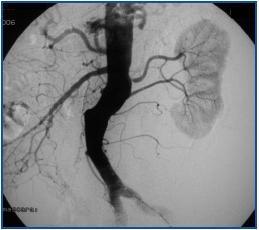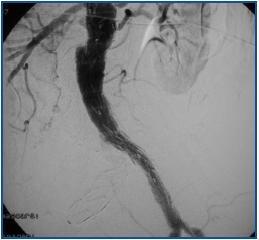Dear Editor:
We present the case of a female patient aged 75 years who has been hypertensive for many years and has a urological history of recurring pyelonephritis, which in June 1992 required a nephrectomy of the right kidney. Since then, she has maintained stable renal function with a glomerular filtration rate between 35-40ml/min/1.73m2 according to the simplified MDRD. In May 2002, a routine abdominal ultrasound examination detected an aneurism of the subrenal abdominal aorta 3.5cm in diameter that is checked periodically. An abdominal CT in July 2006 showed that the aneurism had grown to reach 5.6cm in diameter and that it was accompanied by stenosis of approximately 50% of the left renal artery at the point of origin and of the inferior polar renal artery that irrigated more than a third of the kidney (figure 1). Despite these technical difficulties, in February 2007 we proceeded to place an aortouniliac infrarenal endoprosthesis which left the exit of the polar artery and the left renal artery free (figure 2). From that moment, the patient has maintained a stable renal function with acceptable management of blood pressure.
Aneurisms of the abdominal aorta are a very prevalent condition, with an incidence that varies depending on age and sex. Aneurisms of the abdominal aorta are normally asymptomatic and are detected incidentally. On many occasions, the first sign is rupture (with a low risk for aneurisms ² 5.5cm in diameter, but high for larger diameters) with a mortality rate of 80% for those that break.
For years, elderly patients and those with multiple diseases were not treated surgically, but in 1991 endovascular prostheses arrived on the scene. This technique consists in the placement of a synthetic Y-shaped prosthesis with two arms, one for the abdominal aorta and an iliac artery, and the other for the contralateral iliac artery, which is inserted through the common femoral artery and guided using radioscopy. The prosthesis is located near the neck of the aneurism and the stents that are in place guarantee that it is in the right position, preventing it from shifting.
There are also prostheses with windows for the renal arteries, for cases in which the aneurism affects them as well.
For the case in question, our priority was to preserve the inferior polar artery, which left a short aneurismatic pouch behind. For this reason, we used an aortouniliac prosthesis combined with a femoro-femoral bypass that guaranteed vascularisation of the left leg. At that time, we decided to do nothing about the stenosis of the renal artery, as it was not significant.
By placing endovascular prostheses, we now have less invasive treatment alternative; it has a low mortality rate and provides an option to patients who are not approved for conventional surgery.
Figure 1.
Figure 2.










